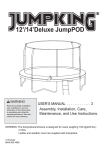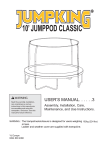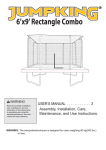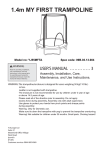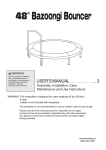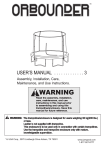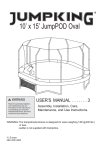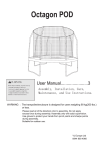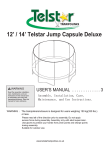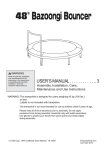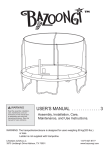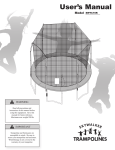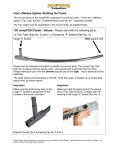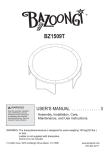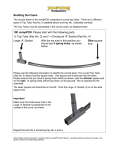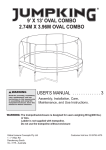Download view/download manual - Jumpking Trampolines
Transcript
10’ Deluxe JumpPOD WARNING Read the assembly, installation, care, maintenance, and use instructions in this manual prior to assembling and using this trampoline/enclosure. Save this manual for future reference. USER’S MANUAL . . . . . . . . . . . . . 3 Assembly, Installation, Care, Maintenance, and Use Instructions. WARNING: The trampoline/enclosure is designed for users weighing 102 kg(224 lbs.) or less. Ladder and weather cover are supplied with trampoline. YJ Europe 0844 800 4060 2 QUESTIONS? If you have questions after reading this manual, please call our toll-free Customer Hot Line. The trained technicians on our Customer Hot Line will provide immediate assistance. Please call our customer hotline: 0844 800 4060 REPLACEMENT PART CONTENTS IMPORTANT PRECAUTIONS . . . . . . . . . . . . . . . . . . . . . . . . . . 4 WARNING LABEL PLACEMENT . . . . . . . . . . . . . . . . . . . . . . . . .6 BEFORE YOU BEGIN . . . . . . . . . . . . . . . . . . . . . . . . . . . . . . . . 7 TRAMPOLINE/ENCLOSURE SAFETY INFORMATION . . . . . . . 8 USE AND INSTRUCTIONAL MATERIAL . . . . . . . . . . . . . . . . . . 12 ASSEMBLY . . . . . . . . . . . . . . . . . . . . . . . . . . . . . . . . . . . . . . . . 16 CARE AND MAINTENANCE . . . . . . . . . . . . . . . . . . . . . . . . . . 25 EXPLODED DRAWING AND PART LIST . . . . . . . . . . . . . . . . .26 ORDERING REPLACEMENT PARTS . . . . . . . . . . . . . . . . . . . .26 3 areas. indoor or shady ing 102 kg (224 lbs.) or less. The trampoline is required forindoor or shady areas. users weighing 102 kg (224 lbs) or less.The 5 26. The trampoline is a rebounding device that propels the user to unaccustomed heights and into a variety of body movements. Rebounding off the trampoline, striking the frame or springs, or improperly landing on the bed may cause injury. or springs, or fall off the trampoline. Attempting maneuvers beyond present skill levels increases the chance of losing control. 29. Injury may result from encountering the frame or falling through the springs while getting onto or off the trampoline or while jumping. Stay in the center of the bed when jumping. Do not use the trampoline without the frame pad securely in place to cover the frame. The frame pad is not designed or intended to support the weight of the user. Do not step or jump directly onto the frame pad. 27. Do not attempt or allow somersaults. This can result in a broken head, neck, back, or leg. Landing on the head or neck can cause serious injury, paralysis, or death, even when landing in the middle of the bed. 28. Jumpers who lose control of their jump may land on the bed incorrectly, land on the frame WARNING LABEL PLACEMENT Label 1 The labels shown on this page have been attached to the trampoline in the indicated locations. The placard will be attached by the owner (see step 7 on page 22). If one of the labels or the placard is missing or illegible, call our Customer Hot Line (see page 3) and order a free replacement label or placard. Attach the label or placard in the location shown. Avoid bouncing when tired. Note: The labels and the placard are not shown actual size. organization. Placard (to be attached by the owner) 6 WARNING PLACARD PLACEMENT The placard shown at the right must be attached to the trampoline enclosure by the owner (see assembly step 11 on page 23). If the placard is missing or illegible, call our Customer Hot Line toll-free at 0844 800 4060, Monday through Friday, 8 a.m. until 5 p.m. Central Time, to order Note: The a free replacement placard. placard is not shown actual size. BEFORE YOU BEGIN Thank you for selecting a jumpPOD trampoline/ enclosure. “jumpPOD” are designed and crafted to provide many years of fun and fitness. This trampoline/enclosure come equipped with warnings and instructions for the assembly, care, maintenance, and use of the trampoline/enclosure. This information must be read by all trampoline supervisors and users before any person is allowed to jump and use enclosure on the trampoline. 7 If you have questions after reading this manual, please call our Customer Hot Line at 0844 800 4060, Monday - Friday, 8 a.m. until 5 p.m. Central Time (excluding holidays). To help us assist you, please mention the name of the product when calling. TRAMPOLINE SAFETY INFORMATION Loss of Control: Jumpers who lose control of their jump may land on the bed incorrectly, land on the frame or springs, or fall off the trampoline. A controlled jump is one where the landing is in the same spot as the takeoff. Before learning a more difficult maneuver, the preceding one should be performed consistently under control. Attempting a maneuver beyond present skill levels increases the chance of loss of control. To regain control and stop your jump, bend your knees sharply when you land. In trampoline use, as in all active recreational sports, participants can be injured. However, there are steps that can be taken to reduce the risk of injury. In this section, primary accident patterns are identified and the responsibilities of supervisors and jumpers in accident prevention are described. ACCIDENT CLASSIFICATION Somersaults (flips): Landing on your head or neck, even in the middle of the trampoline bed, increases the risk of a broken back or neck, which can result in paralysis or death. Such events can occur when a jumper makes an error trying to perform a forward or backward somersault (flip). Do not perform somersaults (flips) on this backyard trampoline. Alcohol or Drug Use: The chance of injury increases when a jumper has consumed alcohol or taken drugs. These substances impair a person’s reaction time, judgment, and physical coordination. Encountering Objects: Use of a trampoline while other people, pets, or objects are underneath it will increase the chance of injury. Jumping while holding or having an object on the trampoline, particularly one that is sharp or breakable, will increase the chance of injury. Placing a trampoline too close to overhead electrical wires, tree limbs, or other obstructions can increase the chance of injury. Multiple Jumpers: More than one jumper on the trampoline increases the chance of a jumper becoming injured by losing control of his or her jump. Jumpers may collide with one another, fall off the trampoline, fall on or through the springs, or land incorrectly on the bed. The lightest weight jumper is the jumper most likely to be injured. Poor Maintenance of the Trampoline: Jumpers may be injured if a trampoline is used when it is in poor condition. A torn bed, bent frame, broken spring, or missing frame pad, for example, should be replaced before anyone is allowed to jump. Inspect the trampoline before each use. Mounting and Dismounting: The trampoline bed is several feet from ground level. Jumping off the trampoline to the ground or any other surface may result in injury. Jumping onto the trampoline from a roof, deck, or other object also represents a risk of injury. Smaller children may need assistance getting onto or down from the trampoline. Climb carefully onto and off the trampoline. Do not step onto the springs or the frame pad. Do not grasp the frame pad to pull yourself onto the trampoline. Weather Conditions : A wet trampoline bed is too slippery for safe jumping. Gusty or high winds can cause jumpers to lose control. To reduce the chance of injury, use the trampoline only under appropriate weather conditions. Striking the Frame or the Springs: Injury may result from encountering the frame or falling through the springs while jumping or getting onto or off the trampoline. Stay in the center of the bed when jumping. Make sure to keep the frame pad in place to cover the frame. The frame pad is not designed nor intended to support the weight of the trampoline user. Do not step or jump directly onto the frame pad. Access: To prevent access to the trampoline by unsupervised smaller children, the access ladder should always be removed and stored in a secure location when the trampoline is not in use. 8 Inspect the trampoline before using it. Do not use the trampoline without the frame pad securely in place to cover the frame. Do not use the trampoline when it is wet or in a windy condition. A worn or damaged bed, spring, or frame piece should be replaced immediately. METHODS OF ACCIDENT PREVENTION The Supervisor’s Role in Preventing Accidents It is the responsibility of the supervisors of trampoline users to provide knowledgeable and mature supervision. They need to know and enforce all the rules and warnings set forth in this manual to minimize the likelihood of accidents and injuries and to inform users of these rules. During periods of time when supervision is unavailable or inadequate, this may require that the trampoline be disassembled, placed in a secure area, or otherwise secured against unauthorized use. Another option that may be considered is covering the trampoline with a heavy tarp that can be secured with locks and chains. It is the responsibility of the supervisor to make sure that the placard with TRAMPOLINE SAFETY INSTRUCTIONS (see step 7 on page 22) is kept posted on the trampoline and that jumpers are informed about these instructions. Keep objects away that could interfere with the jumper. Secure the trampoline against unauthorized and unsupervised use. For the Jumper Do not use the trampoline when under the influence of drugs or alcohol. Avoid bouncing when tired. JUMPING Learn fundamental jumps and body positions thoroughly before trying more advanced skills. Be alert to your own limitations in the execution of trampoline skills. Review this manual to learn how to do basic jumps. The Jumper’s Role in Preventing Accidents Education on the part of the user is a must for safety. Users must first learn a low, controlled bounce and then learn the basic landing positions and combinations before proceeding to intermediate skills. Jumpers must understand why they have to master “control” before they can start thinking about other moves. Understanding the proper progression of skills in jumping on a trampoline must be the first lesson. Review this manual to learn about the basic techniques for using the trampoline. Follow the rules on the placard with TRAMPOLINE SAFETY INSTRUCTIONS (see step 7 on page 22). For further information or additional instructional materials, contact a certified trampoline instructor. Stop your bounce by flexing your knees as your feet come in contact with the trampoline bed. Learn this skill before attempting others. Avoid jumping too high or for too long. Always control your jump. A controlled jump is one where the takeoff and landing spots are the same. Bounce in the center of the trampoline. Focus your eyes on the frame pad. Failure to do so may result in a loss of balance and control. TRAMPOLINE SAFETY INSTRUCTIONS Take turns jumping, one at a time, and always have someone watch you. For the Supervisor GETTING ON AND OFF Read the instructions before using the trampoline. Enforce all of the safety rules and be familiar with the information in this manual to help new users learn basic jumps and all users follow trampoline safety. All trampoline users must have mature, knowledgeable supervision, regardless of the skill or age of the jumper. Climb onto and off the trampoline; do not jump onto it or off it. Do not use the trampoline as a springboard to other objects. For additional information regarding skill training, contact a trainer certification organization. This trampoline is not recommended for use by children under 6 years of age. 9 TRAMPOLINE ENCLOSURE SAFETY INFORMATION NEED FOR TRAMPOLINE ENCLOSURE SAFETY electricity. Lights, electric heaters, extension cords, and household electrical appliances are not permitted in or on the trampoline or enclosure. A trampoline enclosure is a recreational product. The information on this page and on page 11 identifies important safety precautions. The precautions are not all-inclusive, because an enclosure can be used in ways that this manual cannot cover completely. Hazards Associated with Entering and Exiting the Trampoline Enclosure A trampoline enclosure installed on a trampoline is raised off the ground. The height of the enclosure increases the risk of a fall when a jumper is entering or exiting the enclosure. Young children in particular may have difficulty getting into and out of the enclosure. To reduce the risk of falling, help young children to get into and out of the enclosure. To prevent pinches and cuts during enclosure use, a frame pad must be installed on the trampoline. (See the trampoline manufacturer’s instructions.) The frame pad must be installed before the enclosure is erected. The frame pad reduces the chance of injury from accidental contact with the springs and frame. Enter and exit the trampoline enclosure only through the door of the enclosure (the opening in the netting walls). The trampoline bed and the netting walls of the enclosure are separate pieces; jumpers, particularly young children, must not exit the enclosure by going out between the bed and the netting walls. Trying to exit in this way poses a risk of strangulation from being caught between the trampoline frame and the netting walls. USING THE ENCLOSURE SAFELY Adult Supervision of Children Children using a trampoline with a trampoline enclosure must be supervised by adults. Young children must be supervised constantly. Adults must pay particular attention to: • things that children bring into the enclosure. • children’s activities inside the enclosure. • conditions inside the enclosure while children are using it. • the way children get into and out of the enclosure. Darkness increases the chances of a fall when a jumper is entering or exiting the enclosure. Do not use the trampoline unless adequate lighting is provided. Hazards Associated with Animals and Sharp and Breakable Objects Additional details of safe enclosure use are described below. To avoid damage to the trampoline enclosure and the trampoline, do not allow pets or other animals inside of the enclosure. The claws and teeth of animals can damage the netting. Do not jump on the trampoline while holding or wearing a sharp or breakable object. Electrocution Hazard Associated with the Metal Frame of the Trampoline and Enclosure The trampoline and enclosure frames are made of metal. They are not grounded, and they will conduct 10 Hazards Associated with High Winds A trampoline with an enclosure can be moved or blown over by high winds, potentially injuring anyone in its path or anyone inside of the enclosure. If you anticipate high winds, take down the enclosure netting, and stake the trampoline frame to the ground (see page 25), or move the trampoline and enclosure to a sheltered location. Storing the Trampoline Enclosure Safely Specific steps for storing the trampoline enclosure are presented later in this manual. There are specific safety precautions to be aware of when storing the enclosure. Remove the attached tube sections as a unit, and separate them on the ground. Avoid pinching your fingers by keeping your fingers away from pinch points near the bracket assembly while you are removing the tubes from the frame. Placing the Trampoline in a Safe Place There must be at least 7.3 m (24 ft.) of clear, open space above the trampoline bed. Do not place or store anything underneath the trampoline. This trampoline enclosure is not recommended for use by children under 6 years of age or by anyone weighing more than 102 kg (224 lbs.). Use the trampoline only when the bed is clean and dry. Inspect the trampoline and enclosure prior to each use and replace any worn or damaged parts. Use only when the enclosure netting has no holes, the clamps are tightly secured to the tubes and the frame, and the netting is properly suspended. For the Jumper Do not use the trampoline enclosure when under the influence of drugs or alcohol. Avoid jumping too high or for too long. Always control your jump. Take turns jumping one at a time, and always have someone watch you. Do not attempt to jump over the netting. Do not intentionally rebound off the netting. Do not hang from, kick, cut, or climb on the netting. Wear clothing that is free of drawstrings, hooks, loops or anything that could get caught in the netting. To avoid injury, the trampoline must be kept away from objects and possible hazards including electric power wiring, tree limbs, and fences. Do not place the trampoline near any other recreational devices or structures such as a swimming pool or swing set. Do not attach anything to the netting that is not a Bazoongi approved accessory or part of the trampoline enclosure. The trampoline must be placed on a level surface before use, and the area around the trampoline must always be well lighted. Enter and exit the trampoline enclosure only through the door in the netting. To enter the enclosure, first unfasten the plastic clips on the door and unzip the zippers. Place one knee on the frame pad and climb head first through the door. Refasten the plastic clips and close the zippers. For the Supervisor Be familiar with the information in this manual and enforce all of the safety rules. Help new users and all users to use the trampoline and enclosure safely. All trampoline users must have someone watch them, regardless of the skill or age of the user. Secure the trampoline against unauthorized and unsupervised use. Keep the trampoline free of objects that could interfere with the jumper. How to Enter and Exit the Trampoline Enclosure To exit the enclosure, first unzip the zippers on the door and unfasten the plastic clips. Sit on the bed of the trampoline and climb feet first through the door. When you are through the door and sitting on the frame pad, step or jump safely to the ground. Close the zippers and refasten the plastic clips. 11 USE AND INSTRUCTIONAL MATERIAL OVERVIEW OF TRAMPOLINE USE The first periods of trampoline use should focus on learning fundamental body positions and practicing the eight basic bounces that are described on pages 14 and 15 in this manual. During this learning period, jumpers should practice these basic techniques and perfect them. Braking, or checking the bounce, should be taught first and stressed as a safety measure. Jumpers should brake their jump whenever they start to lose balance or control. This is done by simply flexing the knees sharply upon landing and absorbing the upward thrust of the bed. This enables the jumper to stop suddenly and avoid losing control. In trampoline use, the takeoff point and landing point of a good, controlled jump are in the same spot. An exercise is considered learned only when a jumper is able to perform it consistently. Jumpers should never proceed to any advanced step until they can perform all previous techniques consistently. Allow each jumper a brief turn on the trampoline. Extended bouncing exposes an overtired user to an increased risk of injury. Longer turns tend to lessen the interest of others waiting to jump. Clothing should consist of a T-shirt and shorts. Jumpers should wear regulation gymnastic shoes or heavy socks, or they may jump barefoot. Street shoes or tennis shoes should not be worn on the trampoline. Beginning jumpers may wish to wear loose-fitting protective clothes, such as a long-sleeve shirt and pants, until correct landings are mastered. This will reduce the chance of mat (bed) burns from improper landings on elbows and knees. No hard-sole shoes should be worn, as they cause excessive wear on the trampoline bed. Mounting and dismounting properly should be a strict rule from the beginning. Users should climb onto the trampoline by placing their hands on the frame and stepping or rolling up onto the frame, across the springs, and onto the bed. Do not step directly onto the frame pad or grasp the frame pad when mounting or dismounting the trampoline. Users should always place their hands on the frame while mounting or dismounting. To dismount, jumpers should walk to the side of the bed, bend over and place one hand on the frame, and then step from the bed to the ground. If you have installed the optional ladder, its rungs can be used to mount or dismount. Always face the ladder and place your hands on the frame. Make sure your foot has secure contact with the ladder rung when using it. Reckless bouncing should not be permitted. All skills should be learned at moderate heights. Control, rather than height, should be emphasized. Jumpers should be forbidden to practice alone and unsupervised. 12 INSTRUCTIONAL PROGRAM AND MODEL LESSONS The following lessons are examples of an instructional program. They should follow a complete discussion and demonstration of body mechanics between the supervisor and the student(s). See pages 14 and 15 for descriptions of basic trampoline skills. Lesson 1 1. Mounting and dismounting—Demonstration and practice of proper techniques. 2. Fundamental bounce—Demonstration and practice. 3. Braking (checking the bounce)—Demonstration and practice. Braking on command. 4. Hand and knee drop—Demonstration and practice, stressing four-point landing and alignment. Lesson 2 leg is brought forward from the standing (not bouncing) position, and the drop to the back with the chin held forward to the chest and the eyes forward on the frame pad. Spotting this skill is most important. Demonstration of back drop with low bounce and practice of both techniques. Lesson 5 1. Review and practice of skills previously learned, encouraging original routines based on them. 2. Half turntable—Start from the front drop position and push to the left or right with the hands. Turn the head and shoulders in the same direction. Keep the back parallel to the bed and the head up. After completing a half turn, land in the front drop position. Lesson 6 1. Swivel hips—Suggested progression: seat drop, feet, half twist, repeat; seat drop, half twist to feet, repeat; seat drop, half twist to seat drop. 1. Review and practice of skills previously learned. 2. Half turntable. 2. Knee drop—Half twist to the right, to the left, to the feet, and then to the knees. 3. Seat drop—Half twist to the feet. Seat drop, knee drop, hand and knee drop, repeat. Lesson 3 1. Review and practice of skills previously learned. 2. Front drop—To save time and avoid mat (bed) burns, all students should be requested to assume the front drop position on the floor while the instructor checks for faults. Suggested progression: from hand and knee bounce, the body is extended for the landing in the front drop position, and the rebound is made to the feet. 3. Practice routine—Hand and knee drop, front drop, feet, seat drop, half twist to feet. Lesson 4 1. Review and practice of skills previously learned. 2. Back drop—Demonstration, emphasizing the forward thrust of the hips by arching the body as one Lesson 7 The student should now be encouraged to design and organize routines, with emphasis on good form. The instructor may judge or grade students and arrange groupings for further instruction accordingly. To stimulate interest in competition, the game of “Trampoline Horse” can be introduced. Before the game begins, students must count off. To start the game, student number 1 performs a stunt. Student number 2 then mounts the trampoline and performs the same stunt and adds a second stunt. Student number 3 mounts and performs stunts 1 and 2 and adds a third stunt. Thus, the series of stunts is continuously lengthened. The first person to miss a stunt in the series assumes the letter “H” and starts a new series with a stunt. If a person misses again, he assumes the letter “O.” The first person to accumulate “H-O-R-S-E” is eliminated from the game. The last remaining contestant is the winner. Lesson planning from this point should be facilitated by contacting a certified trampoline instructor. 13 BASIC TRAMPOLINE SKILLS Fundamental Bounce Knee Drop 1. Start from a standing position with your head erect and your eyes on the frame pad. 1. Start bouncing from a standing position, keeping your eyes on the frame pad. 2. Swing your arms forward and up in a circular motion. 2. Land on your knees, keeping your back straight and your body erect. 3. Bring your feet together and point your toes downward while in the air. 3. Come back up to an erect position. 4. Keep your feet about 30 cm (15 in.) apart when landing on the bed. Hand and Knee Drop Back Drop 1. Start bouncing from a standing position, keeping your eyes on the frame pad. 1. Start from a low bounce and land on your back. 2. Land on the bed on your hands and knees. 2. Keep your chin forward on your chest as you land. 3. Push with your hands and come back up to an erect position. 3. Kick forward and up with your legs to return to an erect position. 14 Seat Drop Front Drop 1. Land in a sitting position with your legs parallel to the bed. 1. Start from a low bounce and land on the bed in a prone position. 2. Place your hands on the bed beside your hips. 2. Keep your head up and your arms extended forward on the bed. 3. Push with your hands to return to an erect position. 3. Push with your arms to return to an erect position. Half Turntable Swivel Hips 1. Start from the front drop position and push to the left or right with your arms to begin turning your body in the opposite direction. 1. Start with a seat drop. 2. Turn your head to the left or right and swing your arms up in the same direction. 2. Turn your head and shoulders toward the direction that your body is turning. 3. Turn your hips in the same direction as your head and arms, completing a twist. 3. Keep your back parallel to the bed and your head up. 4. Land in the seat drop position. 4. After completing a half turn, land in the front drop position. 15 ASSEMBLY IMPORTANT ASSEMBLY INFORMATION recommended. Provide clearance for wires, tree limbs, and other possible hazards. Lateral clearance is also essential. Place the trampoline/enclosure away from walls, structures, fences, and other play areas. Maintain a clear space on all sides of the trampoline/enclosure. A Phillips Head screw driver is needed to assemble trampoline/enclosure. However, a provided. screwdriver is not Assembly requires two persons. Keep children away from the trampoline/enclosure until it is fully assembled. 3. Use the trampoline/enclosure in a well-lighted area. Artificial illumination may be required for indoor or shady areas. Use gloves to protect your hands from pinch points during assembly. 4. Secure the trampoline/enclosure against unauthorized and unsupervised use. The assembly steps refer to parts by their descriptions and key numbers (see the PART LIST on page 26). If a part is missing, see ORDERING REPLACEMENT PARTS on page 26. 5. Remove any obstructions from beneath the trampoline/enclosure. TRAMPOLINE/ENCLOSURE PLACEMENT 1. Place the trampoline/enclosure on a level surface before use. 6. The owner and supervisors of the trampoline are responsible to make all users aware of practices specified in this manual. 7. The trampoline/enclosure is only to be used as an enclosure for a round trampoline. 2. Adequate overhead clearance is essential. A minimum of 7.3 m (24 ft.) from ground level is 1a. Lay Top Tubes 1 and 2 on the ground as shown in the picture. Ensure that the large Enclosure Socket (4A) is positioned on the right hand end of the left top rail, with the ‘A’ label and screw hole on the outside face. The small Socket (3B) is to be positioned on the right hand end of the right top rail. 1b. Connect the two top rails as shown in the picture. 16 1c. For ease of installation, insert the longer leg (5B) into the smaller Socket(3B). 1d. Insert the Centre 7 (W shape leg) into the Longer leg (5B). 1e. Next, attach the shorter leg (6A) to the Centre 7 (W shape leg) BEFORE inserting into the large Enclosure Socket (4A), as shown in the picture. 1f. Then, place your feet either side of the large Enclosure Socket (4A) to steady the toprail. Next, insert the shorter leg(6A) into the open socket. For extra leverage, place your hands at the bottom of the shorter leg(6A). 17 1g. By anchoring the top rail with your feet, you can pull the pole leg into the open socket. Note: These parts will be under tension. This ensures the legs do not drop out during use. 1h. The finished quadrant will look like this. Next, repeat steps 1 - 7 to complete the remaining 3 quadrants, giving you 4 identical assemblies. 2a. Next, turn each of the 4 quadrants over and connect them together, as shown in the picture. This is best done with 2 people. 2b. This picture shows 2 connected quadrants. 18 2c. This picture shows 2 connected quadrants, as the trampoline frame takes shape. 2d. Then connect the remaining 2 quadrants. When connecting the last part of the ring, it often helps to have another person standing diametrically opposite you, who can push the frame towards you as you connect the final joint. This helps mantain the circular shape. This picture shows the completed assembly of the large Enclosure Socket(4A). This picture shows the completed assembly of the small Socket(3B). 19 3. Lay the Bed (8) on the ground inside of the assembled frame. Make sure that the two warning decals (not shown) are on top of the Bed. 3 Top Holes Frame V-rings 8 Note: There are V-rings around the edge of the Bed (8) and holes around the top of the frame. During this step, you will attach the Bed to the frame using the included Springs (10) for holes on top of frame and for holes on bottom of frame (see the inset drawing). Hook a spring to the Bed(8) and using the spring pulling tool(11), pull the spring from the Bed to the hole slot in the trampoline frame with even spring tension. Be careful where you place your hands, the Springs and frame joints can pinch. 10 10 10 10 To attach each Spring, you will first hook one end of the Spring into a V-ring with black webbing with yelow line location (see the inset drawing). Holes No yellow line Black webbing with yellow line Hook the first Spring(10) into the V-rings (black webbing with yellow line) on the Bed(8) and into the holes on the top tube. Attach one more Springs (10) with black with yellow line location directly across the Bed (with the webbing) from the first Spring. Attach one more Spring(10) with black webbing with yellow line location halfway between the first spring(10), so four Springs(10) are attached as shown. Attach two more Springs(10) (not shown) halfway between the first four Springs(10). Continue attaching Springs(10) halfway between the previously attached Springs,until all the Springs are attached. 21 V-ring 10 Spring: 8 During the installation of springs, wear gloves and protective eye wear. Frame 20 4. Lay the Frame Pad (9) on the frame. Adjust the position of the Frame Pad so the notches are aligned with the Legs (5,6) as shown. Be sure 4 Enclosure Frame Opening are fit to the Enclosure Socket position. 4 Enclosure Frame Opening Do not use the trampoline without the Frame Pad (9), which is designed to reduce the likelihood of injury to the user from coming in contact with the trampoline frame. If you do not have a Frame Pad, contact your dealer to obtain one. Properly install the Frame Pad before using the trampoline. 5 9 6 Notches Frame Pad (9) Enclosure Socket 5. Now attach the yellow warning placard using the enclosed tie warp.Place it at the point where you will normally mount the trampoline.The tie wrap should go around a vertical frame joint and a top rail to keep it from moving laterally. Enclosure Frame Opening 5 10 8 9 5.a Lay the one-piece frame pad on the trampoline so it covers the frame and spring.Make sure the pad completely covers the frame.The pad has eight(8)sets of attachment strings (Figure A).Using the plastic string and drilling throught eyelet and binding on the iron tube. Figure A 5.a Figure B Figure B Elastic Tie-Down Elastic Tie-Down 6 Thread one end of Elastic Tie-Down, then tie a knot on V-Ring. Repeat this step with the remaining straps each pad section (not shown). V-Ring V-Ring Strap with Double D-ring on the pad edge Spring 21 7 7. Using the included plastic tie, attach the Safety Placard (20) to the frame near the point where jumpers will climb onto and off the trampoline. The trampoline is now fully assembled. Make sure that all parts are securely attached. Familiarize yourself and all users of the trampoline with the safety precautions, use and instructional materials, and care and maintenance instructions in this manual before using the trampoline. Frame 20 8 8. Lay a Straight Tube (12) and a Top Straight Tube Tube (13) with Plastic Cap on the ground. 12 17 Make sure that the Straight Tube (12) are oriented so the small holes are in the position shown. note that the ends of the Straight Tube (12) should not be covered. 13 12 17 Insert the Straight Tube (12) into the Top Straight Tube (13). Tighten a Self-tapping Screw (18) into the small hole in the Straight Tubes (13). 17 Small Hole Plastic Cap 17 18 Assemble the remaining Straight Tubes (12), Top Straight Tubes (13), and Foam Sleeves (17) in the same way. Plastic Cap Tighten Self-tapping Screw Into Small Hole 13 9 9. Insert the end of Straight Pole (12,13) into the hole of Enclosure Socket (4). 9 13 Attach the other three Straight Pole (12,13) in the same way. See inset drawing. 8 12 Insert the Completed Straight Pole (12,13) into the hole of Enclosure Socket (4) 13 12 22 9 8 10. Spread out Top G3 Pole (14) joint each section Connector to a straight line. 10 6 Sections Per Line Top G3 Pole (14) Assemble the remaining Top G3 Pole (14) in the same way. Spread the Netting (19) on the trampoline bed, insert a Top G3 Pole (14) into the opening of Top Sleeve on the Netting (19). Insert the other Top G3 Pole (14) into the opposite opening of Top Sleeve on the Netting (19). Spread out G3 Pole and Joint each section to one straight line. 10.a Opening (14) Netting(19) Insert the pole into sleeve of the Netting(19) 11. Joint each end of Top G3 Pole (14) by the clip of connector at each opening. The Top Sleeve of the Netting (19) become a round shape. 11 Joint the end of each pole by Clip of Connector Start: Finish Top Sleeve See inset drawing for attach of Handing Point : Attached Hanging Point: G3 Pole(14) (21) Door of Netting 11.a Netting Hanging point 2 Hanging point 1 Plastic cap(21) Hanging point 3 Hanging point 4 Netting (19) Door of Netting 23 12.Note: During steps 12 and 13, you will “sew”the lower edge of the Netting(8) to the V-rings on the bed using the Cords(22). 12 8 Locate the V-ring closest to the door. Thread one end of a Cord(22)through the lower edge of the Netting(8)above the V-ring and then thread the Cord through the V-ring. Tie the Netting to the V-ring, by making a double knot in the Cord. 22 13.Thread the Cord(22) through the lower edge of the Netting(8) halfway between the first V-ring and the V-ring to the left, and then thread the Cord through the V-ring to the left. Repeat this procedure until the entire Cord is threaded through the Netting and the V-rings as shown. Keep the Cord taut. Tie the end of the Cord to the last Vring that it reaches. 13 8 22 Tie a second Cord(not shown)to the last V-ring reached by the first Cord. Thread the second Cord through the Netting(8) and the V-ring as described above. Repeat this procedure with the remaining Cords until the last Cord reaches the first Cord. (Note: The last Cord may overlap the first Cord.) Make sure that the Netting is sewn to every V-ring on the trampoline bed; the Netting below the door must also be sewn to the V-rings. 14 14.Using the included plastic tie, attach the Safety Placard(20)to the Netting(19) near the door as shown. The trampoline/enclosure is now fully assembled. Make sure that all parts are securely attached. Familiarize yourself and all users of the trampoline/enclosure with the safety precautions, use and instructional materials, and care and maintenance instructions in this manual before using . 19 20 DISASSEMBLY To disassemble the trampoline/enclosure, follow assembly steps 1 through 14 in reverse order. Do not attempt to disassemble any trampoline frame components before the springs and the bed have been removed. Use gloves to protect your hands from pinch points during disassembly. 24 CARE AND MAINTENANCE Care REMOVE AND STORING THE TRAMPOLINE/ ENCLOSURE Do not allow pets or animals on the trampoline or inside the enclosure, as claws may snag and pull the bed material or damage the frame pad or netting. Make sure that the trampoline/enclosure is dry before removing and storing it. Use caution while removing the tubes due to the weight of the tubes. The trampoline/enclosure is intended to be used by one person at a time weighing 102 kg (224 lbs) or less. The user should be either barefoot,wearing socks,or wearing gymnastic shoes. Street shoes or tennis shoes should not be worn on the trampoline.The user should remove all sharp objects from his or her person that may cause injury or damage to the bed.Heavy,sharp, or pointed hard objects should not contact the bed. Appropriate shoes should be worn inside the enclosure to reduce wear to the bed. Once the enclosure is removed from the trampoline, remove all items from the trampoline bed. Make sure that the bed is clean and that it has no tears or holes. Store the trampoline/enclosure in a safe, dry location. SPECIAL CONSIDERATIONS High Wind MAINTENANCE Your trampoline is manufactured using quality materials and crafted to provide you and your family with many years of enjoyment and exercise.Proper maintenance and care will help to prolong the life of the trampoline and reduce the possibility of injury. Prolinged exposure to the sun,especiallu ultraviolet rays, will shorten the life of the enclosure fabric.For longer fabric life,store the enclosure when it is not being used.A dry enclosure,properly stored, will provide the longest life of the fabric, sewing, and hardware.Remove the enclosure from the trampoline during harsh weather conditions or during long periods of non-use. The following guideline should always be observed. Inspect the trampoline / enclosure before each use, and replace any worn,defective or missing parts. The following conditions could represent potential hazards and increase the danger of personal injury: • a missing,improperly positioned or insecurely attached frame pad, netting, enclosure tubes, foam sleeves. • punctures,frays, tears, or holes worn in the bed, frame pad, netting, foam sleeves. • deterioration in the stitching or fabric of the bed, frame pad, netting. • ruptured or missing springs • a bent or broken frame, leg, enclosure tubes • a sagging bed, netting • sharp protrusions on the frame, suspension system, enclosure tubes Stake It is possible for the trampoline/enclosure be blown about by high wind.If you anticipate high winds,the trampoline/enclosure should be moved to a sheltered location, disassembled, or tied down to the ground with ropes and stakes (not included). At least three ropes and three stakes should be used. The tops of the stakes should be at ground level so that they will not create a tripping hazard.In addition,the tops of the stakes should be covered,if necessary,so that users will not be injured by falling onto the stakes. Make sure to attach the ropes to the top of the frame; do not simply secure the legs or the bases to the ground,as they can separate from the frame sockets. Moving the Trampoline If the trampoline/enclosure needs to be nived,it should be moved by two persons, kept horizontal, and lifted slightly. If necessary,the trampoline/enclosure can be disassembled for moving. To disassemble the trampoline/enclosure, follow the assembly steps in reverse order (see pages 11 to 16). Do not attempt to disassemble the frame sections, legs, or bases before the bed and springs have been removed. If any of these conditions exists, the trampoline should be disassembled or otherwise protected against use until the condition is remedied. 25 EXPLODED DRAWING AND PART LIST 17 11 21 13 19 12 8 10 16 9 4 3 1 6 2 5 7 14 20 15 20(User’s Manual) Key No. Qty. 1 2 3 4 5 6 7 8 9 10 11 12 13 4 4 4 4 4 4 4 1 1 1 1 4 4 Description Top Tube (With Socket) Top Tube Socket Enclosure Socket Leg Extension (B) Leg Extension (A) Center Stitched Bed with V-rings Frame Pad Set of Spring Spring Tool Straight Pole Enclosure Top Tube Key No. Qty. 14 15 16 17 18* 19 20 21 2 1 4 8 8 1 1 4 22* * 8 1 Description G3 Pole Ladder Enclosure Socket Cap Foam Sleeve Self-tapping Screw Netting with attached Hardware User’s Manual and Safety Placard (2PCS) Plastic Cap (This part has been attached to the top of the Top Curve Pole(14).) Cord Set of ASTM Frame Labels *This part is not illustrated. Specifications are subject to change without notice. ORDERING REPLACEMENT PARTS To order replacement parts, visit our Web site or call our Customer Hot Line (see page 6,7). To help us assist you, please provide the following information when calling: • • • • • the the the the the MODEL of the trampoline/enclosure NAME of the product KEY NUMBER and DESCRIPTION of the part (see the PART LIST above) quantity needed desired method of shipping 26


























